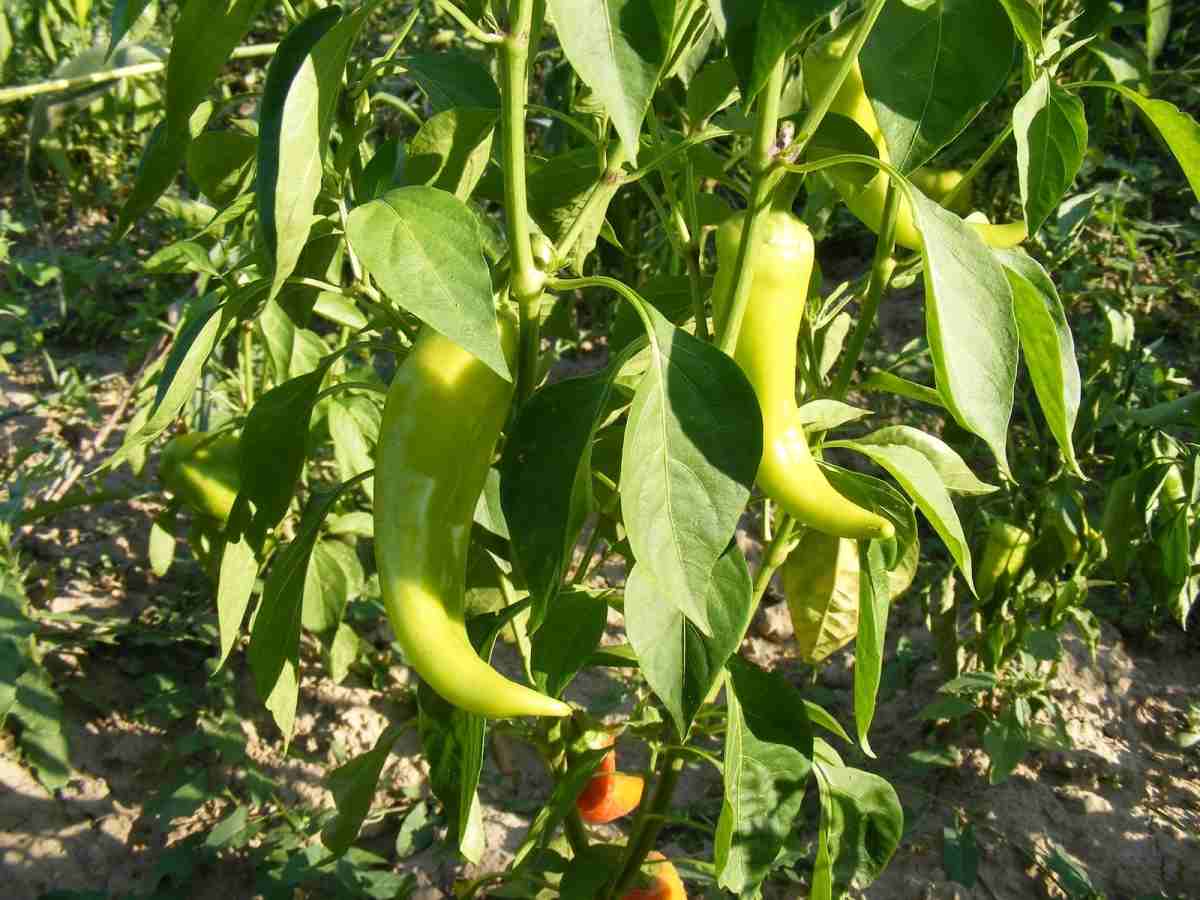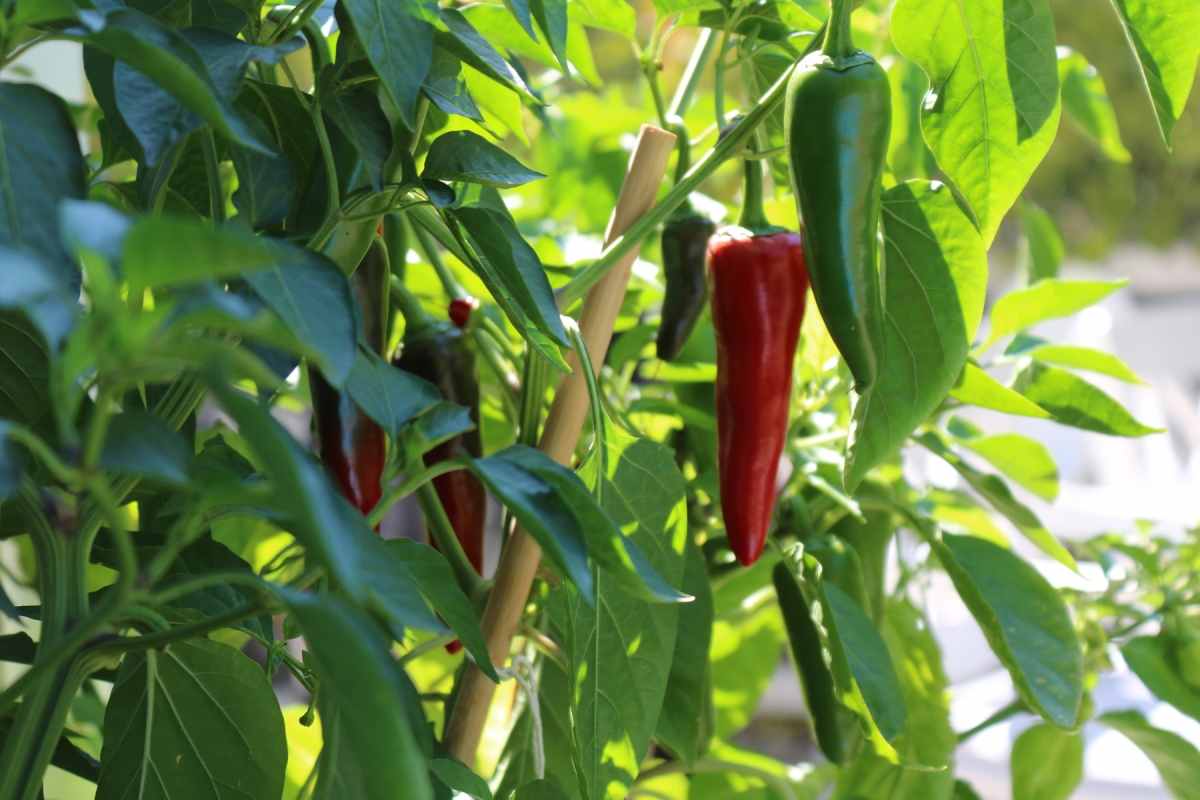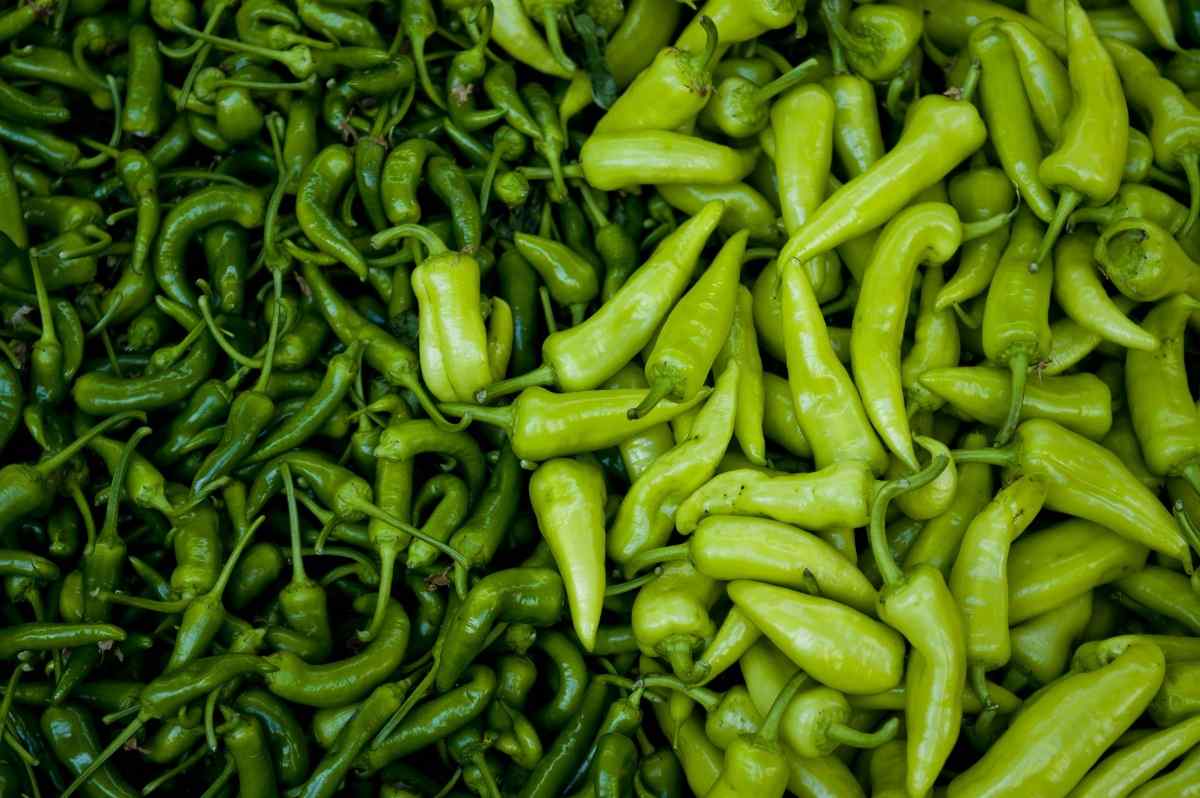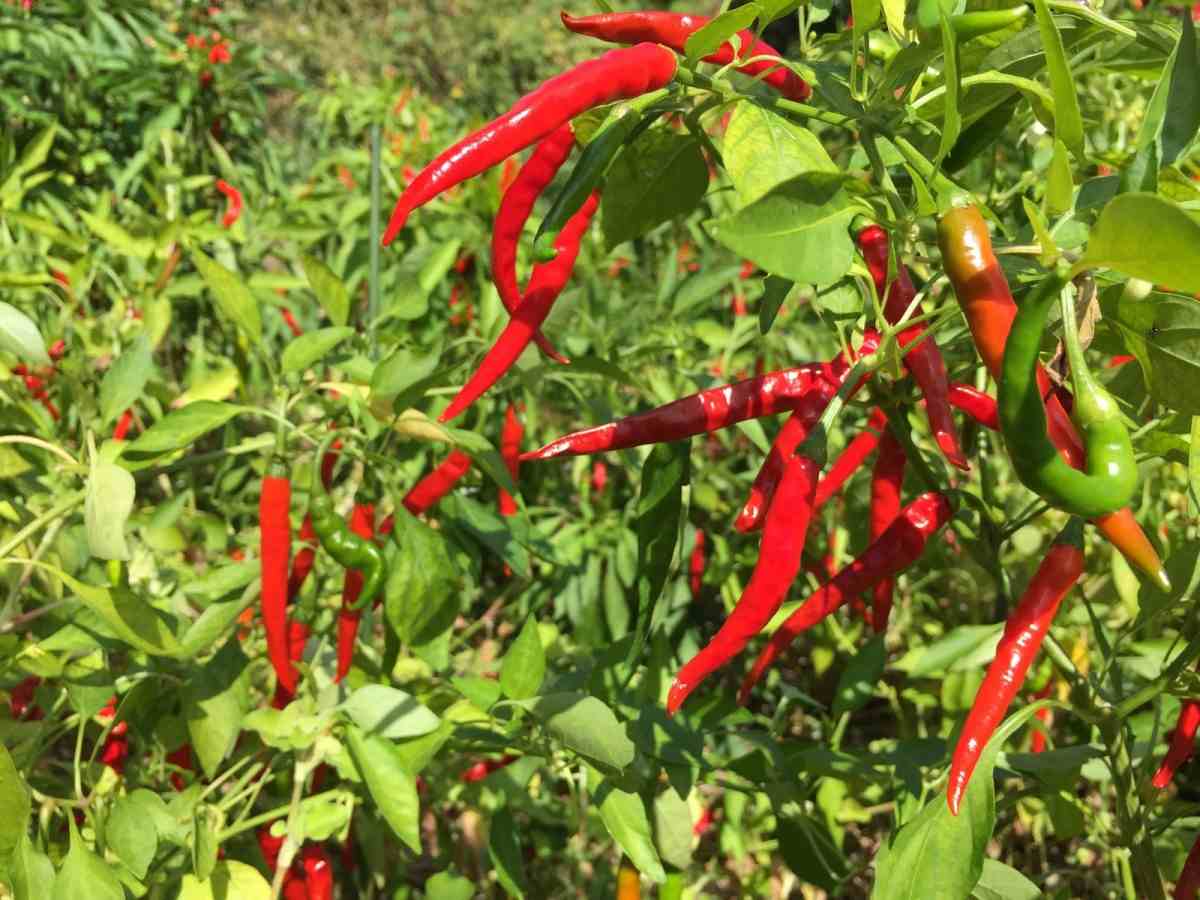Introduction to Organic Chilli cultivation
Organic cultivation is a crop production process respecting the rules of nature and it maximizes the use of farm resources and minimizes the use of off-farm resources. It belongs to the genus Capsicum under the Solanaceae family. The Chilli plant is a white-flowered, dark green, or purple-leaved plant that grows up to about 1.5 meters in height. It is also called hot pepper, cayenne pepper, and sweet pepper, etc. Chilli is botanically called Capsicum annuum. It is a small, annual shrub with an erect, branched shoot and it has a tap root system with simple leaves. The Chilli fruits also similarly hang downwards and seeds are contained within the fruit. In this article we also discussed below topics;
- How do you grow organic Chillies
- Organic fertilizer for Chilli plants
- Organic pests and diseases control in Chillies
- Organic Chilli yield per acre
- Manure application of Chilli plants
- Organic production of Chilli Crops
A step by step guide to Organic Chilli cultivation practices

Various types of Indian Chillies
The different varieties of Indian Chillies are Bhut Jolokia, Kashmiri Chillies, Guntur Chilli, Jwala Chilli, Kanthari Chilli, Byadagi Chilli, Kashmiri Chili, Kashmir, Bangalore Torpedo Chili, and Ramnad Mundu/Gundu, and Dhani.
For organic cultivation, open-pollinated crop varieties are preferred. Seed selection is an important step in organic chilly production and seeds should be carefully selected from the certified organic farms or from farmers’ fields which is raised organically. The seeds (which are not treated with chemicals) from local high yielding varieties can be used in the absence of organically produced Chilli seeds. Choose disease-resistant and locally demand varieties.
Red Chilli, yellow Chilli, Lakhauri Chilli, Janjiri Chilli are some of the traditional varieties whereas Pusa Sadabahar, Pusa Jalwa, Punjab Lal, Bhagya Laxmi, Pant C-1, and Pant C-2 are some of the improved varieties.
Climate required for Chilli cultivation
Chilli crop requires a warm and humid climate for its best growth and dry weather during the maturation of fruits. A temperature ranging from 20 to 25°C is ideal for Chilli. In Chilli fruit development adversely affected at temperatures of about 37°C or more. Heavy rainfall leads to poor fruit set and in association with high humidity leads to rotting of Chilli fruits. High temperature and low relative humidity increase the transpiration during flowering resulting in shedding of buds, flowers, and small fruits.
Soil treatment and planting material for organic Chilli cultivation
Chilli crops like warm soils with good drainage and a hot full sun position. Then, prepare the soil beforehand by mixing in some cow manure, compost, and certified organic pelletized fertilizer.
If Chillies are being planted in an organic farm then the soil should be treated with Azotobacter or Azospirillum. 1 Kg of Azotobacter or Azospirillum is mixed with 50 Kg of farmyard manure. Also, two tonnes of vermicompost is added on a per-acre basis.
Chilli is propagated by seeds. For raising nurseries, seeds of high yielding varieties with tolerance to pests and diseases can be used. They must be carefully selected from certified organic farms or from their seed plot which is raised organically. To start with, chemically untreated seeds from local high yielding varieties could be used, in the absence of organically produced seeds.
The seed rate and seed treatment for Organic Chillies
For varieties use seed rate of about 200 gm/acre and 80-100 gm/acre for hybrids.
Seeds must be sown in an area about 200 m² to prepare the nursery. For Chilli nursery bed preparation, seedbeds of 3 m length and 1.2 m wide are required. The seedbed must be made 10-15 cm high from the ground. 20 kg of rotten cow dung manure, 100 grams of superphosphate, and 50 grams of murate of potash should be added to the bed.
In organic cultivation, Chilli seeds should not be treated with any chemical fungicides or pesticides. Though, it is always beneficial to adopt indigenous practices for seed treatment, wherever possible. The seeds can be treated with Trichoderma and Psuedomonas sp. by 10 g per kg of seed to prevent the incidence of seedling rot in the nursery. The ideal time for Chilli crops raising nursery is February – March. Transplanting can be done during April – May. About 400 g of seeds would be sufficient for raising nursery for transplantation in an area of an acre.
Chilli plant spacing or sowing distance
Chilli plants should be large enough for transplanting at 6-8 weeks old. It is recommended transplanting is at a spacing of about 60 cm in rows 90-105 cm apart with about 17500 plants per hectare.
Organic manuring in Chilli plants
Organic manures are natural products used by farmers to provide food or plant nutrients for the crop plants. The organic manures for Chilli plants are farmyard manure, green manures, compost prepared from crop residues and other farm wastes, vermicompost, oil cakes, and biological wastes such as animal bones, slaughterhouse refuse. Organic manure such as farmyard manure is applied by 4-6 tonnes/acre. Though, it is always advisable to use compost or farmyard manure from their farm rather than from outside the farm. Restriction of use of permitted mineral fertilizers under organic system can be done by depending on the requirement, based on soil analysis. The use of bio-fertilizers can be resorted to in combination with organic inputs.
Irrigation requirement for Organic Chilli cultivation
Chilli crop can’t withstand heavy moisture so apply irrigation only when needed. Heavy irrigation causes lanky vegetative growth and Chilli flower drop. Interval of irrigation mainly depends on soil and climatic condition. If the Chilli plant show dropping at 4 pm, it is an indication of plant needed irrigation. Flowering and fruit development are the most critical stages of water requirement. Stagnation of water must not be allowed in nursery and field as it causes fungal infection.
Interculture practices in Organic Chilli cultivation

Chilli crop can be cultivated organically as an intercrop or mixed crop under organic methods and it is desirable to include a leguminous crop in rotation with Chilli. Generally, two weeding/ hoeing are required to keep the field free from weeds, the first within 20 to 25 days of Transplanting and the other after 20-25 days of the first weeding/hoeing. Weeds that attract pests must be allowed to grow in the field to act as a trap and removed before flowering.
Various types of natural fertilizers and plant food for Chilli plants
Manure – This is one of the most natural materials obtainable on the market as it is made from the excrement of farm animals, starting from cows and horses, and is then mixed with hay and other natural substances and left to mature for about four months before being spread over crops. The ideal format for potted Chilli plants is pelleted manure which is already ready to use without having to wait for it to mature. It is extremely rich in nitrogen, so it’s best to not overuse it.
Compost – This product is the result of several organic materials (can also be made at home using cooking scraps, leftover water from plants, or with manure and organic materials and leaving them in the composter). It can be used as a fertilizer but only in later stages and can be used in place of soil.
Earthworm humus – It is also called ‘vermicompost’, this product is an organic substance produced by earthworms thanks to the processing of manure and various plant waste. The final product is a brown powder, similar in appearance to the soil but odorless. It’s one of the best natural fertilizers for Chilli plants because it contains many nutritive elements, prevents fungal diseases, makes overused earth more fertile and conducive to growth, and can be used at every phase of the plant’s life.
Bat guano – It is another natural fertilizer derived from certain types of animal excrement, such as marine birds and bats. It can be found in pellet or powder form and is rich in nutritive elements such as phosphorus and potassium. It is fundamental to regulate the dosage you apply (usually one dose every 1 to 2 months).
Chicken manure – It is similar to the manure, but made from the excrement of chickens, hens, and other birds. It’s used in its natural form, left to mature as compost, but it can also be found in pellet form.
Coffee – As strange as it sounds, the grains leftover from homemade coffee work as a natural fertilizer. Just let them dry out and then sprinkle it over the soil and in this way we can obtain a mixture that’s rich in potassium, magnesium, calcium, potassium, and other minerals.
Organic strategies for managing pests in Chilli crops
For organic Chilli production, spray infected plants with soapy water. Then, add a couple of drops of dish soap to a spray bottle top up with water and shake to dissolve. Spray the solution liberally over the plant, remembering to reach all parts of the Chilli plant, including the undersides of leaves. The soapy water traps and suffocates the aphids.
Organic strategies for managing pests;
- Learn to tolerate some damage – Most healthy Chilli plants can tolerate some damage without suffering serious long-term problems or crop yield reduction. Munched leaves or damage pods can easily be removed to maintain the attractive appearance of your plant.
- Introduce the ‘Good guys’ – Aphids feeding in the spring can alarm many Chilli growers. Introducing natural predators such as Ladybirds, Parasitic wasps and Lacewings will also help clean up most local infestations in a month or so.
- Handpick or Hunt down – Hunting down snails and slugs and ‘disposing of them’ can be a highly satisfying exercise particularly if the little blighters have already struck prized plants. Nighttime ‘slug hunts’ during wet weather can be mainly productive.
- The Water Hose – A strong water hose will temporarily dislodge flies, aphids, and other pests from mature Chilli plants. However, be careful not to saturate or damage Chilli plants and avoid this using method on young seedlings.
- Remove diseased plants or plant parts – Simply removing and disposing of badly damaged plants can help reduce the problem and prevent is spreading to adjacent plants.
- Crop Rotation -This is an important strategy for tackling soil-borne pathogens such as Verticillium Wilt and root rot.
- Grow pest resistant and pest tolerant plants – Many hybridized varieties, some of the newer sweet pepper varieties have been developed to give specific resistance to diseases such as Tobacco Mosaic Virus (TMV) and Bacterial Leaf Spot.
Normally, Organic pest and disease control for Chilli crop involves the cumulative effect of many techniques, including;
- Allowing for an acceptable level of disease and pest damage;
- Encouraging predatory beneficial insects to control pests;
- Careful crop selection, choosing disease-resistant varieties;
- Planting companion crops that discourage and divert pests;
- Using row covers to protect plants during pest migration periods;
- Using pest regulating plants and the biologic pesticides, fungicides, and herbicides
- Using no-till cultivation techniques as false seedbeds
- Rotating crops to different locations from year to year to interrupt pest and disease reproduction cycles
- Using insect traps to monitor and control insect populations that cause damage as well as transmit diseases.
Each of these methods also provides other benefits such as soil protection and improvement, fertilization, pollination, water conservation, and season extension, etc. and these advantages are both complementary and cumulative in overall effect on farm health. Effective organic pest and disease control requires an understanding of pest life cycles and interactions. Crop protection in organic cultivation is not a simple matter and it depends on a thorough knowledge of the crops grown and their likely pests, pathogens, and weeds.
The organic Chilli harvesting procedure

Chilli is highly perishable and it requires more attention during harvest, storage, and transportation. Chilli harvesting should be done at the right stage of maturity. Dark green fruit must be plucked for preparing Chilli pickle. For dry Chilli and for making Chilli powder, picking must be done when the fruit is dark red. Ripe fruits are to be harvested at frequent intervals and retaining fruits for a long period on the plants causes wrinkles and color fading. Chilli crop is ready for harvesting in about 90 days after transplanting. About 5 to 6 pickings are made for dry Chilli and 8-10 pickings for green Chilli.
Chilli harvesting is done according to the intended use of Chilli and for making Chilli powders and dry Chilli; the fruits are harvested when the Chilli turns dark red. The green Chilli fruit is plucked for preparing Chilli pickles. However, ripe fruits should be plucked at regular intervals. Retaining them in the Chilli plant for a longer period can cause color fading and wrinkles. Green Chillies can be plucked 8 to 10 times while ripe ones are plucked 5-6 times.
According to the crop variety, climatic conditions, soil, and growth conditions, fresh Chilli yield varies from 30-40 quintal per acre. 25 to 35 Kg of dried Chilli is obtained out of a total of 100 Kg of fresh Chilli. Dry Chilli’s average yield varies from 7.5 to 10 quintals per acre.
Commonly asked questions about Organic Chilli cultivation

How long do Chillies take to grow after flowering?
After successful fertilization, full-size green Chillies develop within 55 days, although these fruits are often referred to as unripe. You can cut some of these Chillies from the plant and allow others to ripen longer.
Why Chilli plant leaves curling up?
Overwatering can cause Chilli leaves to curl due to the roots’ inability to access enough oxygen and nutrition from the soil. Overwatering will also usually because of yellowing leaves and stunted plant growth. Water only when the soil has become mostly dry.
How many hours of the sun do Chilli plants need?
Chillies are a fruiting plant, and usually, require a minimum of 5 hours of direct sunlight per day to grow properly.
Why are the leaves falling off my Chilli plants?
Both overwatering and under watering can result in Chilli plant leaf drop. Don’t run for the hose in the heat of the day if you see the Chilli leaves wilting.
Why is my Chilli plant dying?
Occasionally, Chillies wilt because they are baking in the hot sun. If you’re watering Chilli plants sufficiently, the cause is likely fungal wilt. A Chilli plant that is wilting from lack of water will recover very quickly.
Hello Jagdish Reddy,
You have put in some great information on dry chillies farming. This information needs to be spread across all dry chilli farmers in Karnataka and Andhra Pradesh as we see huge crop damages this year especially.
Regards,
Ramakrishna Melgiri
Red chilli in telangana
We will update soon about Red Chilli Farming in Telangana and Andhra pradesh